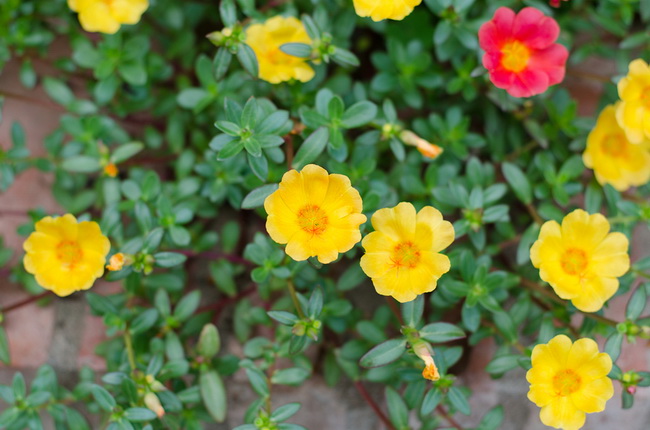- Make It Yourself Lavender Heart-Shaped Bath Bombs!
- 20 Things You Never Knew About “Down There”
- 12 Best Foods For Those Suffering From Arthritis Pain
- 12 Personal Hygiene Mistakes Almost Everyone Makes (Mom Never Told You About #4!)
- 15 Medicinal Plants And Herbs From The Cherokee People
- 12 Mind-Blowing Benefits Of Drinking Coconut Water During Pregnancy
- 12 Outstanding Winter Foods That Won’t Fatten You Up Like A Christmas Turkey
Why You Should be Eating More Edible Weeds like Purslane

Photo credit: bigstock.com
1. Omega-3 Essential Fatty Acid
Now this is something no one really expects to find in a plant. However, like flax seed, you can find ALA in purslane, and plenty of it, too. Our bodies convert ALA (alpha linoleic acid) into omega-3 fatty acid. Most vegetarians miss out on this because they don’t eat fish. Well, here is some good news for all you vegans (and those of you who don’t like fish). Purslane is a super-rich source of ALA, so even the strictest vegans can still benefit from the omega-3’s that this weed contains.
Scientists don’t know exactly how much of the ALA we eat gets changed into omega-3s, but ALA also offers us anti-inflammatory effects as well as protection for our heart function, so it’s all good. The omega-3 we do get helps our body make compounds that regulate and support our immune system, help control our weight, and regulate our blood pressure and clotting abilities, as well as prevent certain types of cancer.
2. Vitamins and Minerals
On top of the ALA, purslane offers us plenty of minerals including coper, calcium, magnesium, manganese, phosphorus, and zinc. It’s loaded with beneficial nutrients such as vitamin E, riboflavin, beta carotene, vitamin C, and vitamin A, which has shown to have significant tumor-fighting ability, especially in the areas of lung cancer and oral cancer.
Purslane also contains pectin, which is known to reduce the “bad” (LDL) cholesterol, dopamine, and Co-Q10, a substance that is found in every living cell and supplies them with energy. It’s also a great source of all the B-complex vitamins. Read more how to fight with vitamin B12 deficiency.
SEE ALSO: Grow Your Own Herbal Salve Garden with These 10 Plants
3. Super Rich in Melatonin
University of Texas researchers have shown that purslane has as much as 20 times more melatonin than any other green. Melatonin can help to regulate our sleep cycles. It’s also been shown in other studies to be a powerful, cancer-growth-inhibiting force. Purslane has more melatonin than any other fruit or vegetable in the world, so why would you want to pull it out of your garden and throw it away?
Make your own purslane tincture
Many people like tinctures, as they can get all the health benefits without actually having to consume the entire plant. Although purslane is super low in calories (only 16 tiny calories in 100 grams) perhaps you don’t care for the taste, or you want to continue to get the health benefits even in the winter when purslane is dormant. You can still get all the benefits and make it easy for your body to absorb all the nutrients by using a tincture. Make your own! It’s so easy.
- Harvest some purslane from your garden or yard. If you can’t find any, go to a field, park, or even alongside the road, it grows just about everywhere. The leaves should be fresh and green. Don’t pick any leaves that are yellow, wilted, or rotten. Take a good quantity as you will be chopping it up into smaller pieces.
- Once you have enough, sterilize a Mason jar and its lid by submerging them in boiling water for about 5 minutes. Allow to cool.
- Chop your purslane into very small pieces. Fill the cooled Mason jar about ¾ of the way full.
- Add unflavored vodka (it can be the cheap stuff!) until the liquid covers the purslane completely. Shake gently to remove air bubbles. Top it off if necessary.
- Seal the jar and give it a few more good shakes. Place it in a cool, dark spot, like a kitchen cupboard away from the stove.
- Shake the jar once per day. Allow to sit for 2 months. This allows the medicinal compounds and essential oils in the purslane to transfer to the liquid.
- After 2 months, get another sterilized jar and wash your hands well. You don’t want to contaminate your tincture with any type of bacteria. Strain the liquid into the new jar using a cheese cloth. Squeeze the cheese cloth so that you get out as much liquid as you can.
- Throw out the purslane. Shake your new purslane tincture before each use!
You can always eat purslane raw, put it in a salad, or try it in a sandwich in place of lettuce. You can chop it and use it in omelets, casseroles, or soups. Don’t overcook purslane or it tends to get a bit slimy. If you are adding it to a cooked dish, add it in the last 10 minutes of cooking time, to avoid overcooking it.
Enjoy your newfound “weed”!
Sources:

































oreo
Mar 13, 2015 at 7:02 pm
You are showing a picture of Portulaca grandiflora (moss-rose) which is a plant gardeners grow for their many colored of flowers. Do you also advocate eating the garden flower plant, moss-rose? I know that you can eat the ‘weed’ Portulaca oleracea (purslane) http://www.nutrition-and-you.com/purslane.html